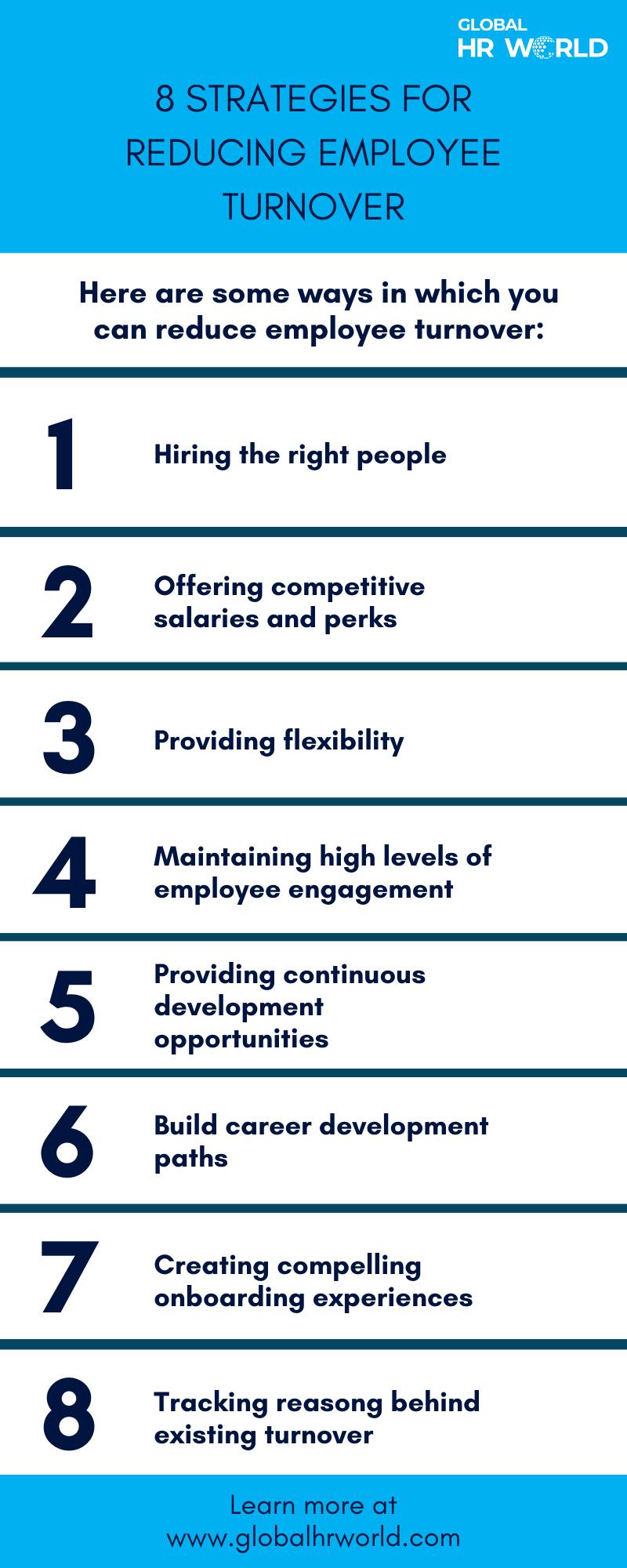Employee turnover is a significant challenge businesses face across the globe. There are various reasons behind this loss of employees, ranging from the company’s culture to the work-life balance a role lends. However, in many cases turnover can be reduced and employees can be retained with the right approach. This article will go over 8 strategies for reducing employee turnover so you can minimize how many of your employees walk out on you.
Having an arsenal of strategies for reducing employee turnover is essential for organizations, as hiring and training new talent is an expensive and time-consuming task. Furthermore, finding people who are a good fit for your organization’s culture is even more difficult. Thus, filling up a vacancy left behind an employee that has left can be a challenging task. Hence, businesses can use the following strategies for reducing employee turnover to prevent such a situation from happening:
Here are eight strategies for reducing employee turnover
Strategy 1: Hire the Right People
Employee-organization fit is a salient predictor of turnover and retention. Employees who feel aligned with their workplace are less likely to leave because their values and goals are in harmony with the organization’s. On the other hand, a poor fit can lead to new hires leaving within the first 90 days. Thus, organizations should thoroughly get to know potential hires to determine if they will be with the company for a long time.
Strategy 2: Offer Competitive Salaries and Perks
Another crucial predictor of employee retention is the compensation offered to them. Since jobs are an employee’s livelihood, the pay and benefits they get should be enough to afford them a comfortable life, free of financial stress. Incidentally, one of the top reasons why people change jobs is for higher pay. Thus, make sure you offer your employees a fair and sustainable wage and give them additional benefits that create more security and stability in their lives.
Strategy 3: Provide Flexibility
According to FlexJobs, 80% of employees have reported that they’d be more loyal to their organization if it offered greater flexibility and 30% have cited the lack of flexible work options as their reason for leaving. In other words, employees are looking for employers that give them multiple working options, such as remote work, flexitime, shorter work weeks, or hybrid schedules. Employees’ priorities are shifting when it comes to how much time they want to physically spend at work, especially after remote work became the convention due to 2020 lockdowns and pandemic restrictions.
Strategy 4: Maintain High Levels of Employee Engagement
Employee engagement is another very critical metric affecting turnover and retention. If employees don’t feel engaged at work, their productivity plummets and they are much more likely to leave. For this reason, businesses should focus on fostering employee engagement in different ways, from social enrichment to meaningful work. According to a Gallup study, 70% of the variance in employee engagement depends on their relationship with their manager. Hence, this is a major area to invest in and improve if you’re looking to increase the level of employee engagement in your organization.
Strategy 5: Provide Continuous Development Opportunities
Another strategy for retaining employees is to offer continuous development opportunities, be it through internal training programs or by partnering with reputed educational institutions and industry leaders to offer courses, certifications, and degrees to your employees at discounted prices. Employees value development opportunities, and many have reported prioritizing workplaces that do invest in employee development. Providing continuous development opportunities increase growth potential within the same organization, preventing employees from considering switching when they want to make a bigger leap in their career.
Strategy 6: Build Career Development Paths
Along with continuous development opportunities through learning initiatives and programs, employee retention can also be increased by offering personalized career development paths to employees. Make it routine practice to help/enable employees to articulate and follow their desired paths at your organization, supporting them in coming up with a plan to achieve these goals. In this way, employees will have a long-term picture of their career trajectory and, most importantly, will have it within the same organization, increasing the likelihood of retention and reducing turnover.
Strategy 7: Create Compelling Onboarding Experiences
Organizations shouldn’t underestimate the importance of onboarding experiences in reducing employee turnover. If you onboard new recruits on the right foot, they are more likely to stay. On the other hand, a negative onboarding experience doubles the chances of new recruits looking for new opportunities. Create an engaging and exciting onboarding program that gives new recruits a meaningful but fun glimpse into the company, their role, their teams, and their managers. Put positive interactions and support front and center so employees feel confident and trusting of the new workplace right from the start.
Strategy 8: Track Reasons Behind Existing Turnover
Lastly, continuously track the reasons behind existing turnover to find issues and patterns. Then, fix these issues by involving leadership, HR, L&D, and external or internal consultants and specialists.
Infographic

Knowledge Check!
Frequently Asked Questions (FAQs)
What are some strategies to reduce employee turnover?
Strategies to reduce employee turnover range from hiring the right people and onboarding employees the right way to providing development opportunities and continuously employee engagement.



